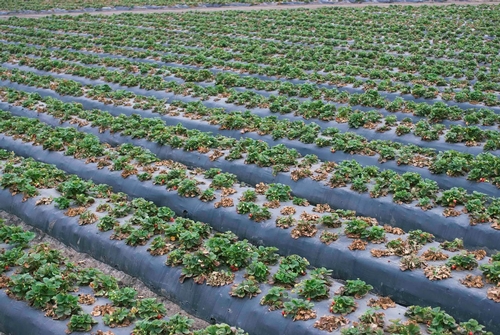
I Have a Diagnosis of Macrophomina or Fusarium in My Strawberry Field – Now What Do I Do?
Accompanying the current spate of Macrophomina and Fusarium discoveries by the UCCE Diagnostic Laboratory in Salinas and by other pathologists, growers, farm managers, and PCAs are now faced with the question of what the next step should be.
Fumigation: The advice for growers and farm managers is to avoid bed fumigation at this juncture. Even beds fumigated by professional operators will have little reservoirs of surviving pathogens on the shoulders where the fumigant did not travel. Of great concern are pathogen populations surviving in the soil making up the untreated furrows. Growers who are not flat fumigating with methyl bromide + chloropicrin should consider using a high rate of chloropicrin under impermeable film. This likely will not be as good a treatment as the mix of methyl bromide + chloropicrin used in the past, but it is the next best soil treatment solution.
Reducing stress to the plants: The diseases caused by both Macrophomina and Fusarium develop earlier, more rapidly, and more severely if plants are stressed. Strawberries that are under-chilled or subject to irrigation deficits, fertility shortfalls, and/or pest issues (such as mites) can succumb fairly rapidly, while those perfectly managed can withstand disease for a longer time. Growers wanting to reduce their diseases losses from here on out will need to play a tight defensive game and address plant stress factors in a timely manner.
Not disturbing the existing bed: The in-field spread of both Macrophomina and Fusarium is mainly accomplished by tillage and other procedures that move soil around. Because neither pathogen makes airborne spores (such as those made by powdery mildew and gray mold pathogens) or swimming zoospores found in soil water (produced by Phytophthora), the spread of inoculum is only by physical movement of the soil. Presumably, beds remaining intact and in place, as they would be for second year strawberries or other system of minimal tillage, will keep the pathogen from being spread to non-infested parts of the field.
This situation has been observed locally. In 2013, a strawberry field had significant Macrophomina outbreaks in certain parts of the field. Held over for a second year, the dead areas were replanted and again developed disease in those sections; however, second year plants that were healthy in 2013 were mostly healthy in 2014. While growing second year strawberries is not being recommended, this type of situation demonstrates the key role of soil movement in disease epidemiology.
Sanitation: Sanitation is critical for limiting the spread of Macrophomina and Fusarium. Tractors, tillage equipment, and irrigation pipes moving from infested fields should be cleaned. Remember too that a strawberry field that had significant dieback two years ago and is now planted to lettuce or another crop, likely still has plenty of Fusarium or Macrophomina around. It is a good practice for all of us to pay attention to where we have been and clean up if you are coming out of an infested field.
Having the Right Attitude and Accept the Changing Reality: In this environment of new diseases and reduced to no availability of good fumigants, those able to keep open minds and adopt new practices stand the best chance to weather the storm from these new pathogens. Growers and agricultural professionals of all stripes MUST adapt to this new era. Go to meetings, keep up to date on the latest research, talk with reputable professionals and be ready to make the changes necessary to keep your crop the most productive it can possibly be.

Photo progression- Field with Macrophomina June 21. Photo by Steven Koike, UCCE.

Photo progression - same field as above with Macrophomina- July 5. Photo by Steven Koike, UCCE.

Photo progression - Same field as above with Macrophomina July 26. Photo by Steven Koike, UCCE.
